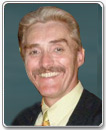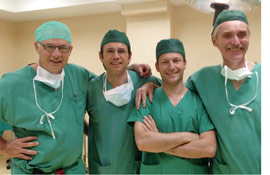An International Perspective
The course, designed to be small to allow for better interaction with faculty and participants, was attended by 10 physicians and surgeons from Israel, Saudi Arabia, Russia, and Italy. The unifying thread amongst them was their dedication to the diabetic foot and the desire to enhance their understanding of the disease and its treatments (with a primary focus on surgical management). Aside from myself, Chris Attinger, MD (Washington, D.C.) also participated on the teaching faculty. In addition to lecturing, both of us assisted on cases in the operating room, with Dr Attinger instructing observers on appropriate flap development and refinements in the technique for below knee amputation. I was fortunate to assist in a Charcot midfoot reconstruction with application of a circular frame – the Ilizarov way. Dr Alexander Kirienko, trained by Professor Ilizarov in Kurgan, was a Master at building the frame ring by ring and hinge by hinge. It is hard for us in the USA to believe, but no X-rays nor fluoroscopy was used during the case! An excellent result was achieved using only osteotomes and curettes. (Figure 1) Other operations performed during the week included an intramedullary nail for a neuropathic ankle, several ray amputations, and typical incision and drainages for limb-threatening infections.
Perhaps the greatest value of the course was the camaraderie that developed within the group and the lively discussions that took place in and out of the hospital. This networking is always the most enjoyable aspect of international meetings. It is remarkable how similar we all are and yet how differently we might approach similar diabetic foot disorders. Friendships were forged that will be long lasting. (Figure 2). And, of course, the food and wine in Italy is always something to look forward to! The highlight of the trip was a dinner arranged by our host high on the hills overlooking Lago Maggiore (Figure 3). A spectacular meal with an awesome view was a great way to end the course.
Opportunities such as this are always open to you. We will be repeating this course periodically in the years ahead and I do hope that some Americans with a similar interest will attend as well. Yes, it is a big world, but the Diabetic Foot World is a small, connected world populated by dedicated professionals from numerous specialties. American Podiatry, unique as it is, perfectly fits into this niche. You’ll see what I mean when you start attending international courses such as this. See you in Milan next time?
Robert Frykberg, DPM, MPH |


 I just returned from a glorious week in Milan, Italy. After several prior trips to this former capitol city, this was the first time I actually encountered beautiful weather – everyday. The occasion for the trip was the first Diabetic Foot International Summer School of Surgery – “real life in a multidisciplinary diabetic foot center”. The course was directed by my good friend Giacomo Clerici, MD – a self described “interventional diabetologist”. Dr Clerici runs a very busy and highly regarded diabetic foot center at the IRCCS Multimedica Hospital in Milan. Interestingly, he is one of the very few operating diabetologists in the world (only to be found in Italy). His knowledge and experience in foot surgery and limb salvage is really quite remarkable. Based on his experiences at the center with former Director Ezio Faglia, MD, he has authored a good number of papers dealing with the diabetic foot, limb salvage, and peripheral arterial disease (PAD). Specifically, the most impressive aspect of the combined writings of his team is that dealing with endovascular management of ischemic diabetic feet. I am not one to be easily impressed, but I am quite impressed with the skills of the interventional cardiologists at Multimedica. The first day of the course was spent in the angiography suite where we witnessed some amazing revascularizations with fine wires and balloons. An extraordinary procedure we observed was a retrograde entry into the Posterior Tibial Artery via the Dorsalis pedis and plantar loop, meeting more proximally to an antegrade catheter that could not cross the occlusion from above. Once the rendezvous was accomplished, the PTA was opened with a balloon down to the plantar artery and the flow was restored. The other two leg vessels were approached from the ipsilateral antegrade femoral artery puncture, restoring flow to the foot in all three arteries. Amazing!
I just returned from a glorious week in Milan, Italy. After several prior trips to this former capitol city, this was the first time I actually encountered beautiful weather – everyday. The occasion for the trip was the first Diabetic Foot International Summer School of Surgery – “real life in a multidisciplinary diabetic foot center”. The course was directed by my good friend Giacomo Clerici, MD – a self described “interventional diabetologist”. Dr Clerici runs a very busy and highly regarded diabetic foot center at the IRCCS Multimedica Hospital in Milan. Interestingly, he is one of the very few operating diabetologists in the world (only to be found in Italy). His knowledge and experience in foot surgery and limb salvage is really quite remarkable. Based on his experiences at the center with former Director Ezio Faglia, MD, he has authored a good number of papers dealing with the diabetic foot, limb salvage, and peripheral arterial disease (PAD). Specifically, the most impressive aspect of the combined writings of his team is that dealing with endovascular management of ischemic diabetic feet. I am not one to be easily impressed, but I am quite impressed with the skills of the interventional cardiologists at Multimedica. The first day of the course was spent in the angiography suite where we witnessed some amazing revascularizations with fine wires and balloons. An extraordinary procedure we observed was a retrograde entry into the Posterior Tibial Artery via the Dorsalis pedis and plantar loop, meeting more proximally to an antegrade catheter that could not cross the occlusion from above. Once the rendezvous was accomplished, the PTA was opened with a balloon down to the plantar artery and the flow was restored. The other two leg vessels were approached from the ipsilateral antegrade femoral artery puncture, restoring flow to the foot in all three arteries. Amazing!



